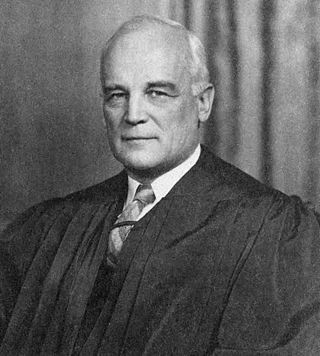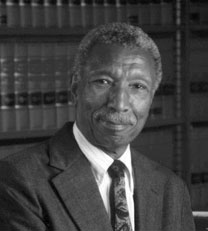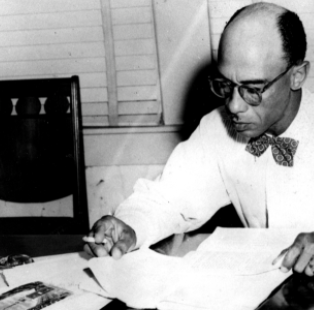
Thurgood Marshall was an American civil rights lawyer and jurist who served as an associate justice of the Supreme Court of the United States from 1967 until 1991. He was the Supreme Court's first African-American justice. Prior to his judicial service, he was an attorney who fought for civil rights, leading the NAACP Legal Defense and Educational Fund. Marshall was a prominent figure in the movement to end racial segregation in American public schools. He won 29 of the 32 civil rights cases he argued before the Supreme Court, culminating in the Court's landmark 1954 decision in Brown v. Board of Education, which rejected the separate but equal doctrine and held segregation in public education to be unconstitutional. President Lyndon B. Johnson appointed Marshall to the Supreme Court in 1967. A staunch liberal, he frequently dissented as the Court became increasingly conservative.
Brown v. Board of Education of Topeka, 347 U.S. 483 (1954), was a landmark decision by the U.S. Supreme Court which ruled that U.S. state laws establishing racial segregation in public schools are unconstitutional, even if the segregated schools are otherwise equal in quality. The decision partially overruled the Court's 1896 decision Plessy v. Ferguson, which had held that racial segregation laws did not violate the U.S. Constitution as long as the facilities for each race were equal in quality, a doctrine that had come to be known as "separate but equal". The Court's decision in Brown paved the way for integration and was a major victory of the civil rights movement, and a model for many future impact litigation cases.
Separate but equal was a legal doctrine in United States constitutional law, according to which racial segregation did not necessarily violate the Fourteenth Amendment to the United States Constitution, which nominally guaranteed "equal protection" under the law to all people. Under the doctrine, as long as the facilities provided to each "race" were equal, state and local governments could require that services, facilities, public accommodations, housing, medical care, education, employment, and transportation be segregated by "race", which was already the case throughout the states of the former Confederacy. The phrase was derived from a Louisiana law of 1890, although the law actually used the phrase "equal but separate".

Lloyd Lionel Gaines was the plaintiff in Gaines v. Canada (1938), one of the most important early court cases in the 20th-century U.S. civil rights movement. After being denied admission to the University of Missouri School of Law because he was African American, and refusing the university's offer to pay for him to attend a neighboring state's law school that had no racial restriction, Gaines filed suit. The U.S. Supreme Court ultimately ruled in his favor, holding that the separate but equal doctrine required that Missouri either admit him or set up a separate law school for black students.

Harold Hitz Burton was an American politician and lawyer. He served as the 45th mayor of Cleveland, Ohio, as a U.S. Senator from Ohio, and as an associate justice of the Supreme Court of the United States.
McLaurin v. Oklahoma State Regents, 339 U.S. 637 (1950), was a United States Supreme Court case that prohibited racial segregation in state supported graduate or professional education. The unanimous decision was delivered on the same day as another case involving similar issues, Sweatt v. Painter.

Robert Lee Carter was an American lawyer, civil rights activist and a United States district judge of the United States District Court for the Southern District of New York.
The University of Texas School of Law is the law school of the University of Texas at Austin, a public research university in Austin, Texas. Texas Law is consistently ranked as one of the top law schools in the United States and is highly selective—registering the 8th lowest acceptance rate among all U.S. law schools for the class of 2022—with an acceptance rate of 17.5%. According to Texas Law’s 2019 disclosures, 90 percent of the Class of 2019 obtained full-time, long-term bar passage required/JD advantage employment nine months after graduation.

Heman Marion Sweatt was an African-American civil rights activist who confronted Jim Crow laws. He is best known for the Sweatt v. Painter lawsuit, which challenged the "separate but equal" doctrine and was one of the earliest of the events that led to the desegregation of American higher education.
Missouri ex rel. Gaines v. Canada, 305 U.S. 337 (1938), was a United States Supreme Court decision holding that states which provided a school to white students had to provide in-state education to Black students as well. States could satisfy this requirement by allowing Black and white students to attend the same school or creating a second school for Black students.
William J. Durham (1896–1970) was a resident of Sherman, Texas for much of his life. He was notable as an African-American attorney and leader in the civil rights movement.
Murray v. Pearson was a Maryland Court of Appeals decision which found "the state has undertaken the function of education in the law, but has omitted students of one race from the only adequate provision made for it, and omitted them solely because of their color." On January 15, 1936, the court affirmed the lower court ruling which ordered the university to immediately integrate its student population, and therefore created a legal precedent making segregation in Maryland illegal.
The Thurgood Marshall School of Law (TMSL) is an ABA-accredited law school at Texas Southern University in Houston, Texas. It awards Juris Doctor and Master of Law degrees. Thurgood Marshall School of Law is a member-school of the Thurgood Marshall College Fund and Association of American Law Schools.
Sipuel v. Board of Regents of the University of Oklahoma, 332 U.S. 631 (1948), is a per curiam United States Supreme Court decision involving racial segregation toward African Americans by the University of Oklahoma and the application of the Fourteenth Amendment to the United States Constitution.

The Bizzell Memorial Library, known also as Bizzell Library, is a five-story brick structure located at the University of Oklahoma in Norman, Oklahoma. It is an elaborate Collegiate Gothic or Cherokee Gothic building, designed by the architecture firm Layton Hicks & Forsyth and erected in 1928 during the administration of OU's fifth president, William Bennett Bizzell.
The Colored Teachers State Association of Texas (CTSAT) was created in 1884 to unite black educators across the state of Texas. The main goals were to create equality in the public school system under Jim Crow laws and to establish a black institution of higher education as outlined in the Texas Constitution of 1876. The organization operated for eighty-two years until its voluntary dissolution in December 1966.
George W. McLaurin was an American professor, and the first African-American to attend the University of Oklahoma.

The Heman Marion Sweatt Travis County Courthouse is the county courthouse for Travis County, Texas. Located in downtown Austin, Texas, the courthouse holds civil and criminal trial courts and other functions of county government. The courthouse was built between 1930 and 1931 in the then-contemporary PWA Moderne style, and it was later expanded in 1958 and 1962.
William Astor Kirk was a professor, author, a church lay leader and a social activist who worked for racial equality, gay rights, and to end segregation in the United Methodist Church. He also served in the Office of Economic Opportunity, after being appointed by President Lyndon Baines Johnson. A contemporary of Heman Sweatt he sought equal access to higher education at the University of Texas and eventually was the first African-American to be awarded a political science doctorate by UT.
Romeo Marcus Williams was an American civil rights attorney who organized large-scale student protests against segregation in Marshall, Texas. He was also a junior partner of Dallas, Texas civil rights attorney, William J. Durham, who served as lead counsel on two landmark U.S. Supreme Court cases, Sweatt v. Painter, and Smith v. Allwright.









